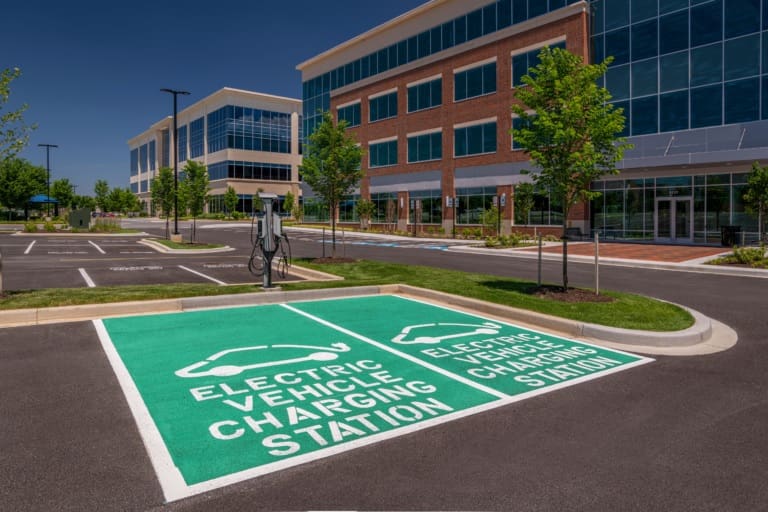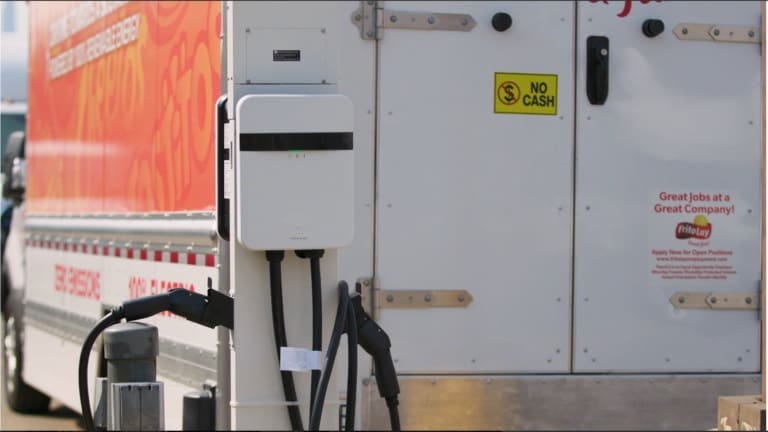
Content presented by NAIOP Maryland
In 2023, Maryland ranked among the top 10 states for electric vehicle (EV) adoption in the country and that is presenting commercial real estate owners with a growing challenge: How do you meet the charging needs of tenants with EVs or entire electric fleets?
At St. John Properties, Inc. “we were early adopters,” said Ryan Schwabenbauer, Assistant Vice President, Sustainability. “We installed our first charging station in 2009, well in advance of the widespread public embrace of EVs.”
Since then, St. John Properties has analyzed EV adoption, installed 77 charging stations across its portfolio of commercial properties and deployed a practice of installing EV charging infrastructure (the electrical conduit but not the chargers themselves) when it constructs new office or flex buildings.
“I used to pass by some of our charging stations and they would be empty. I was concerned that we were too far ahead of demand,” Schwabenbauer said. “That’s not the case anymore. Now, I see EVs utilizing the chargers at every property I visit.”
In addition, the number of prospective tenants requesting EV charging capabilities onsite — both for personal vehicles and company fleets — has risen noticeably.
Meeting the market for EV charging services, however, is not easy.
While St. John Properties can cover the operational costs of the charging system through its hourly charging fees, the company has to absorb the cost of installing the infrastructure.
Combined state and utility incentives “come close to covering those costs, but not consistently,” Schwabenbauer said. “Funding pools run out so we can never be confident that our project is going to be funded and, if it isn’t, that could be a direct financial hit to our company. If the incentives were consistent and approximately 15 percent higher, we could scale Level 2 charging infrastructure across the construction of our new buildings.”
Retrofitting older properties to support EV charging is a bigger challenge. St. John Properties recently put out bids to install EV charging infrastructure at two existing, Class A office buildings.
“That’s very costly – in the tens of thousands of dollars,” Schwabenbauer said. “It would involve directional boring and potentially tearing up parking lots. Those are costs we are not recouping. There needs to be some kind of value driver to have those projects make sense financially.”

Prologis has created a formal program to address EV charging needs. Prologis Mobility is a service offering in which Prologis covers the costs of installing charging infrastructure and gives tenants access to proprietary charging and system management software.
The service has not yet expanded to the company’s Maryland sites but is expected to in the near future. According to Dan Loflin, Head of Commercial, Prologis Mobility, some properties are well suited for the service.
“As EV adoption for both personal and commercial use increases, the demand for charging infrastructure presents both opportunities and challenges,” Loflin said. “Currently, short-haul drayage and last-mile properties are the most suitable options for EV infrastructure installations. These types of properties align with the strengths of EVs. The financial feasibility of these installations depends on several factors and part of the work done by our mobility team — i.e. site acquisition, working with utility companies for grid optimization — can help improve the economics for our customers.”
Grid optimization, however, is a huge undertaking and necessary for some sites supporting electric fleets.
A last-mile vehicle — such as an Amazon delivery truck — typically requires around 20 kW of power whereas a Class 8 vehicle — such as a large tractor trailer— might need closer to 100kW, Loflin said.
“In large-scale deployments, the power demands can quickly surpass the existing grid supply at a property, requiring an upgrade or the installation of a new utility service,” he added.
Completing that upgrade “can be a lengthy and complex process…particularly in buildings that were not originally constructed with EV infrastructure in mind,”Loflin said.
Providing EV charging services widely on commercial properties, he said, will require accelerating interconnection timelines, increasing investment in transmission, developing state-level incentive programs to help scale private investment in infrastructure improvements, permitting on-site power generation when power cannot be provided by the utility, and simplifying local-government permitting of those projects.











